Special Report
This is the City in Every State Where COVID-19 is Growing the Fastest
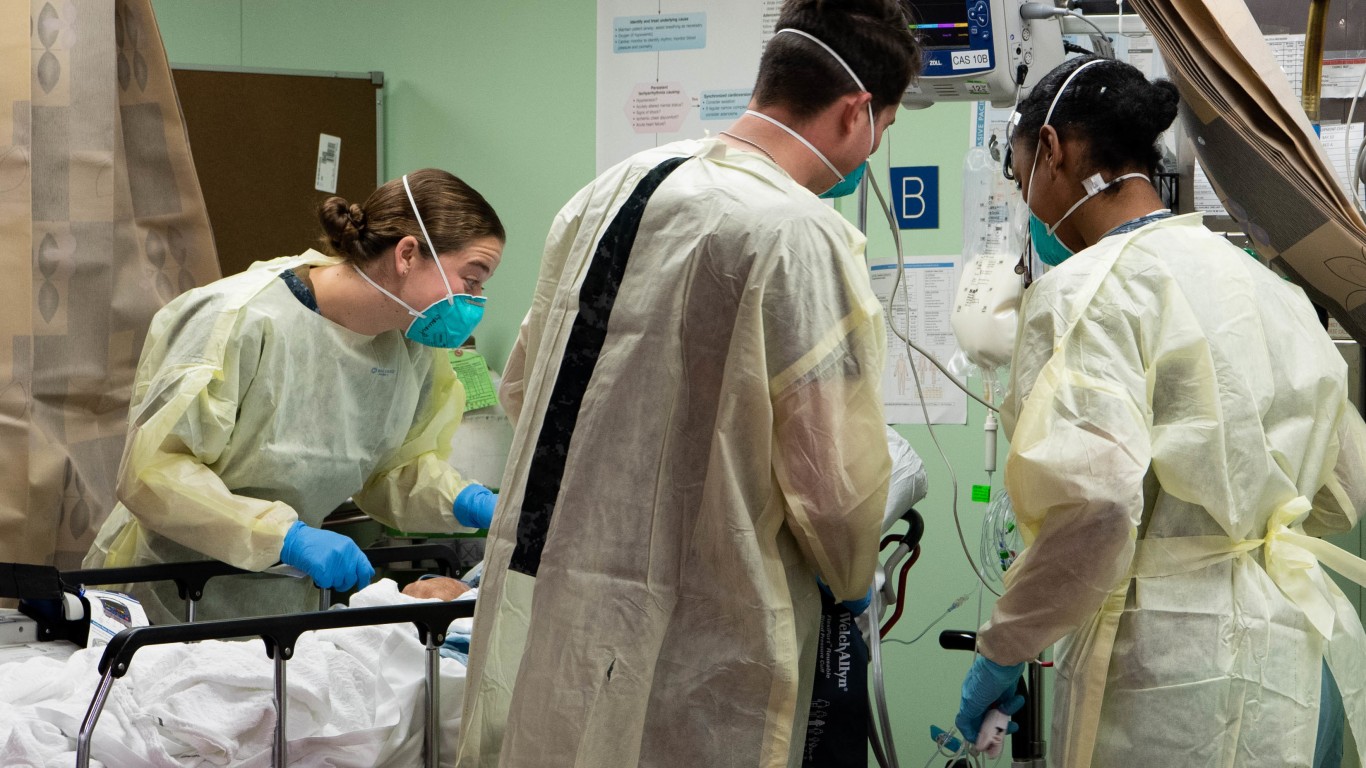
Published:

The U.S. has reported more than 84.5 million confirmed COVID-19 cases as of June 14. There have been more than 1,001,000 reported deaths from COVID-19-related causes — the highest death toll of any country.
The extent of the spread of the novel coronavirus continues to vary considerably from state to state, and from city to city. Even as the number of daily new cases is flattening or even declining in some parts of the country, it is surging at a growing rate in others.
Nationwide, the number of new cases is growing at a steady rate. There were an average of 32.3 daily new coronavirus cases per 100,000 Americans in the week ending June 14, essentially unchanged from the week prior, when there were an average of 32.1 daily new coronavirus cases per 100,000 people.
Metropolitan areas with a high degree of mobility and a large population may be particularly vulnerable to outbreaks. While science and medical professionals are still studying how exactly the virus spreads, experts agree that outbreaks are more likely to occur in group settings where large numbers of people routinely have close contact with one another. Cities with high concentrations of dense spaces such as colleges, correctional facilities, and nursing homes are particularly at risk.
The city with the highest seven-day average of new daily COVID-19 cases per capita is in Hawaii. In the Urban Honolulu, HI, metro area, there were an average of 84.5 daily new coronavirus cases per 100,000 residents in the week ending June 14, the most of any U.S. metro area. Other cities where COVID-19 is growing the fastest include Springfield, IL; Miami-Fort Lauderdale-Pompano Beach, FL; and Kahului-Wailuku-Lahaina, HI.
To determine the metropolitan area in each state where COVID-19 is growing the fastest, 24/7 Wall St. compiled and reviewed data from state and local health departments. We ranked metropolitan areas according to the average number of new daily COVID-19 cases per 100,000 residents in the seven days ending June 14. Data was aggregated from the county level to the metropolitan area level using boundary definitions from the U.S. Census Bureau. Population data used to adjust case and death totals came from the U.S. Census Bureau’s 2019 American Community Survey and are five-year estimates. Unemployment data is from the Bureau of Labor Statistics and is seasonally adjusted.

Alabama: Daphne-Fairhope-Foley
Avg. new daily cases in Daphne in week ending June 14: 31.5 per 100,000
Avg. new daily cases in Daphne in week ending June 7: 23.1 per 100,000
COVID-19 cases in Daphne as of June 14: 57,166 (26,859.9 per 100,000)
Peak pandemic unemployment in Daphne: 16.3% (April 2020)
Daphne population: 212,830 (133.9 people per sq. mi.)

Alaska: Anchorage
Avg. new daily cases in Anchorage in week ending June 14: 39.5 per 100,000
Avg. new daily cases in Anchorage in week ending June 7: 36.9 per 100,000
COVID-19 cases in Anchorage as of June 14: 145,193 (36,398.3 per 100,000)
Peak pandemic unemployment in Anchorage: 14.8% (April 2020)
Anchorage population: 398,900 (15.2 people per sq. mi.)
These are all the counties in Alaska where COVID-19 is slowing (and where it’s still getting worse).
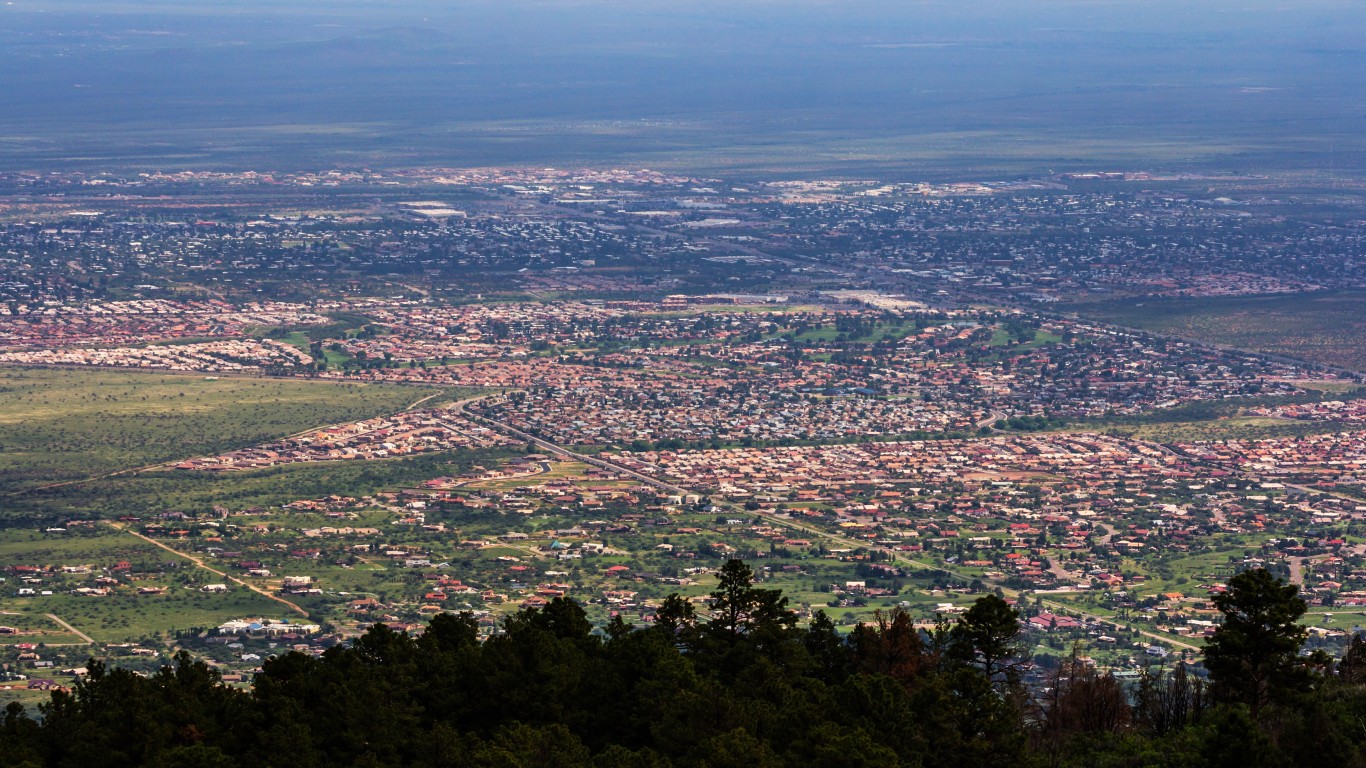
Arizona: Sierra Vista-Douglas
Avg. new daily cases in Sierra Vista in week ending June 14: 31.5 per 100,000
Avg. new daily cases in Sierra Vista in week ending June 7: 19.1 per 100,000
COVID-19 cases in Sierra Vista as of June 14: 32,307 (25,667.6 per 100,000)
Peak pandemic unemployment in Sierra Vista: 11.3% (April 2020)
Sierra Vista population: 125,867 (20.4 people per sq. mi.)

Arkansas: Jonesboro
Avg. new daily cases in Jonesboro in week ending June 14: 25.9 per 100,000
Avg. new daily cases in Jonesboro in week ending June 7: 17.9 per 100,000
COVID-19 cases in Jonesboro as of June 14: 46,544 (35,464.5 per 100,000)
Peak pandemic unemployment in Jonesboro: 9.3% (April 2020)
Jonesboro population: 131,241 (89.5 people per sq. mi.)

California: San Jose-Sunnyvale-Santa Clara
Avg. new daily cases in San Jose in week ending June 14: 61.3 per 100,000
Avg. new daily cases in San Jose in week ending June 7: 62.9 per 100,000
COVID-19 cases in San Jose as of June 14: 389,734 (19,605.8 per 100,000)
Peak pandemic unemployment in San Jose: 12.0% (April 2020)
San Jose population: 1,987,846 (742.1 people per sq. mi.)

Colorado: Boulder
Avg. new daily cases in Boulder in week ending June 14: 62.4 per 100,000
Avg. new daily cases in Boulder in week ending June 7: 67.0 per 100,000
COVID-19 cases in Boulder as of June 14: 72,674 (22,533.9 per 100,000)
Peak pandemic unemployment in Boulder: 9.8% (April 2020)
Boulder population: 322,510 (444.1 people per sq. mi.)

Connecticut: Hartford-East Hartford-Middletown
Avg. new daily cases in Hartford in week ending June 14: 23.8 per 100,000
Avg. new daily cases in Hartford in week ending June 7: 27.6 per 100,000
COVID-19 cases in Hartford as of June 14: 252,740 (20,927.8 per 100,000)
Peak pandemic unemployment in Hartford: 9.9% (July 2020)
Hartford population: 1,207,677 (797.4 people per sq. mi.)

Delaware: Dover
Avg. new daily cases in Dover in week ending June 14: 37.7 per 100,000
Avg. new daily cases in Dover in week ending June 7: 50.0 per 100,000
COVID-19 cases in Dover as of June 14: 54,385 (30,778.3 per 100,000)
Peak pandemic unemployment in Dover: 17.3% (May 2020)
Dover population: 176,699 (301.4 people per sq. mi.)
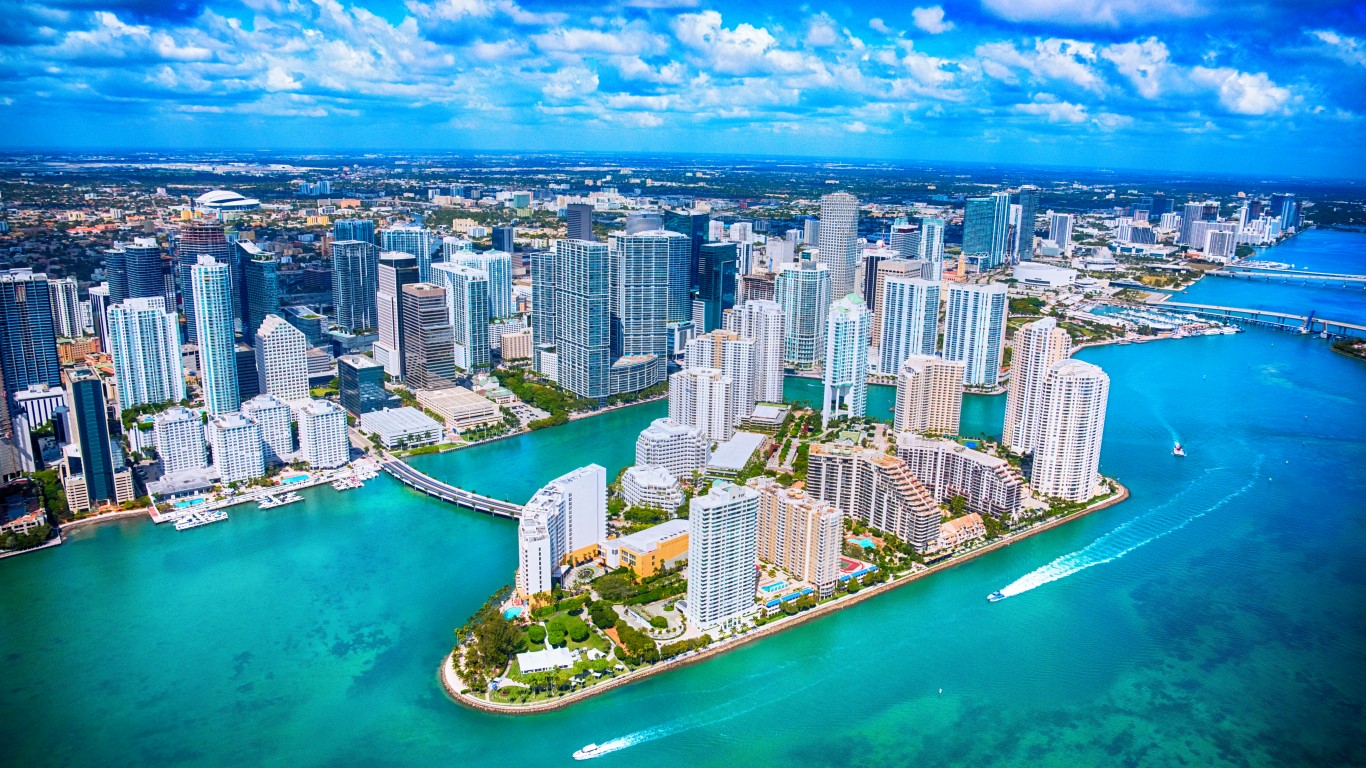
Florida: Miami-Fort Lauderdale-Pompano Beach
Avg. new daily cases in Miami in week ending June 14: 71.5 per 100,000
Avg. new daily cases in Miami in week ending June 7: 83.1 per 100,000
COVID-19 cases in Miami as of June 14: 2,349,579 (38,576.8 per 100,000)
Peak pandemic unemployment in Miami: 13.8% (April 2020)
Miami population: 6,090,660 (1,199.6 people per sq. mi.)

Georgia: Savannah
Avg. new daily cases in Savannah in week ending June 14: 37.6 per 100,000
Avg. new daily cases in Savannah in week ending June 7: 18.2 per 100,000
COVID-19 cases in Savannah as of June 14: 89,266 (23,123.8 per 100,000)
Peak pandemic unemployment in Savannah: 15.7% (April 2020)
Savannah population: 386,036 (288.1 people per sq. mi.)

Hawaii: Urban Honolulu
Avg. new daily cases in Urban Honolulu in week ending June 14: 84.5 per 100,000
Avg. new daily cases in Urban Honolulu in week ending June 7: 88.1 per 100,000
COVID-19 cases in Urban Honolulu as of June 14: 201,572 (20,467.9 per 100,000)
Peak pandemic unemployment in Urban Honolulu: 20.7% (April 2020)
Urban Honolulu population: 984,821 (1,639.3 people per sq. mi.)
These are all the counties in Hawaii where COVID-19 is slowing (and where it’s still getting worse).

Idaho: Boise City
Avg. new daily cases in Boise City in week ending June 14: 27.1 per 100,000
Avg. new daily cases in Boise City in week ending June 7: 19.4 per 100,000
COVID-19 cases in Boise City as of June 14: 208,158 (29,287.4 per 100,000)
Peak pandemic unemployment in Boise City: 12.6% (April 2020)
Boise City population: 710,743 (60.4 people per sq. mi.)
These are all the counties in Idaho where COVID-19 is slowing (and where it’s still getting worse).

Illinois: Springfield
Avg. new daily cases in Springfield in week ending June 14: 84.0 per 100,000
Avg. new daily cases in Springfield in week ending June 7: 64.9 per 100,000
COVID-19 cases in Springfield as of June 14: 64,147 (30,667.8 per 100,000)
Peak pandemic unemployment in Springfield: 15.3% (April 2020)
Springfield population: 209,167 (176.8 people per sq. mi.)

Indiana: Michigan City-La Porte
Avg. new daily cases in Michigan City in week ending June 14: 33.9 per 100,000
Avg. new daily cases in Michigan City in week ending June 7: 26.6 per 100,000
COVID-19 cases in Michigan City as of June 14: 26,776 (24,307.8 per 100,000)
Peak pandemic unemployment in Michigan City: 21.6% (April 2020)
Michigan City population: 110,154 (184.1 people per sq. mi.)
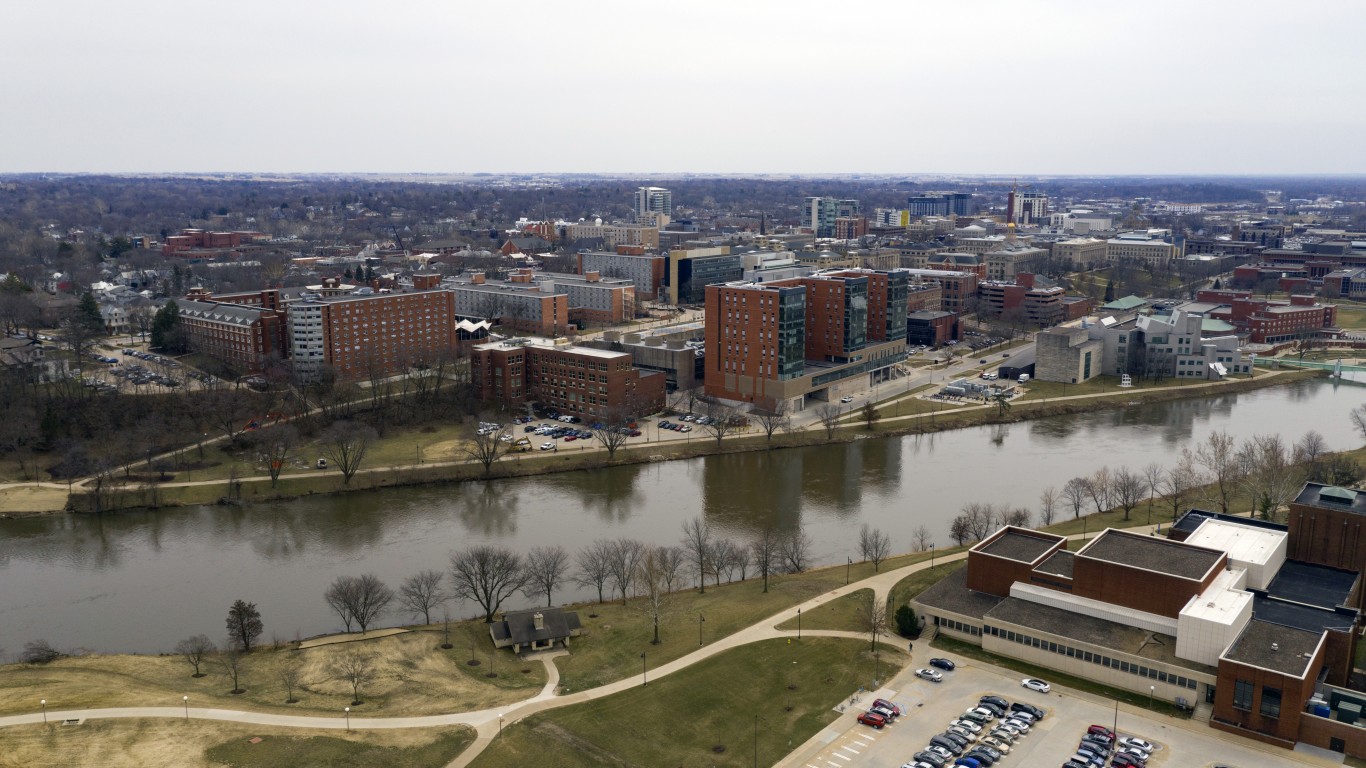
Iowa: Iowa City
Avg. new daily cases in Iowa City in week ending June 14: 37.0 per 100,000
Avg. new daily cases in Iowa City in week ending June 7: 39.5 per 100,000
COVID-19 cases in Iowa City as of June 14: 43,272 (25,353.2 per 100,000)
Peak pandemic unemployment in Iowa City: 10.1% (April 2020)
Iowa City population: 170,677 (144.3 people per sq. mi.)
These are all the counties in Iowa where COVID-19 is slowing (and where it’s still getting worse).

Kansas: Lawrence
Avg. new daily cases in Lawrence in week ending June 14: 31.0 per 100,000
Avg. new daily cases in Lawrence in week ending June 7: 38.4 per 100,000
COVID-19 cases in Lawrence as of June 14: 28,336 (23,556.4 per 100,000)
Peak pandemic unemployment in Lawrence: 12.1% (April 2020)
Lawrence population: 120,290 (263.9 people per sq. mi.)
These are all the counties in Kansas where COVID-19 is slowing (and where it’s still getting worse).

Kentucky: Lexington-Fayette
Avg. new daily cases in Lexington in week ending June 14: 47.4 per 100,000
Avg. new daily cases in Lexington in week ending June 7: 33.1 per 100,000
COVID-19 cases in Lexington as of June 14: 158,547 (31,048.3 per 100,000)
Peak pandemic unemployment in Lexington: 15.8% (April 2020)
Lexington population: 510,647 (347.7 people per sq. mi.)
Louisiana: Houma-Thibodaux
Avg. new daily cases in Houma in week ending June 14: 33.9 per 100,000
Avg. new daily cases in Houma in week ending June 7: 17.3 per 100,000
COVID-19 cases in Houma as of June 14: 57,012 (27,127.6 per 100,000)
Peak pandemic unemployment in Houma: 13.1% (April 2020)
Houma population: 210,162 (91.4 people per sq. mi.)

Maine: Portland-South Portland
Avg. new daily cases in Portland in week ending June 14: 21.5 per 100,000
Avg. new daily cases in Portland in week ending June 7: 26.1 per 100,000
COVID-19 cases in Portland as of June 14: 105,297 (19,789.9 per 100,000)
Peak pandemic unemployment in Portland: 10.9% (April 2020)
Portland population: 532,075 (255.8 people per sq. mi.)
These are all the counties in Maine where COVID-19 is slowing (and where it’s still getting worse).

Maryland: Cumberland, MD-WV
Avg. new daily cases in Cumberland in week ending June 14: 32.0 per 100,000
Avg. new daily cases in Cumberland in week ending June 7: 27.5 per 100,000
COVID-19 cases in Cumberland as of June 14: 26,075 (26,442.0 per 100,000)
Peak pandemic unemployment in Cumberland: 14.0% (April 2020)
Cumberland population: 98,612 (131.1 people per sq. mi.)

Massachusetts: Pittsfield
Avg. new daily cases in Pittsfield in week ending June 14: 37.5 per 100,000
Avg. new daily cases in Pittsfield in week ending June 7: 50.4 per 100,000
COVID-19 cases in Pittsfield as of June 14: 28,292 (22,378.5 per 100,000)
Peak pandemic unemployment in Pittsfield: 18.3% (June 2020)
Pittsfield population: 126,425 (136.4 people per sq. mi.)

Michigan: Ann Arbor
Avg. new daily cases in Ann Arbor in week ending June 14: 46.1 per 100,000
Avg. new daily cases in Ann Arbor in week ending June 7: 53.8 per 100,000
COVID-19 cases in Ann Arbor as of June 14: 88,016 (23,982.6 per 100,000)
Peak pandemic unemployment in Ann Arbor: 15.5% (April 2020)
Ann Arbor population: 367,000 (519.9 people per sq. mi.)

Minnesota: Duluth, MN-WI
Avg. new daily cases in Duluth in week ending June 14: 40.0 per 100,000
Avg. new daily cases in Duluth in week ending June 7: 36.0 per 100,000
COVID-19 cases in Duluth as of June 14: 75,129 (25,974.0 per 100,000)
Peak pandemic unemployment in Duluth: 12.9% (May 2020)
Duluth population: 289,247 (27.5 people per sq. mi.)

Mississippi: Jackson
Avg. new daily cases in Jackson in week ending June 14: 42.1 per 100,000
Avg. new daily cases in Jackson in week ending June 7: – per 100,000
COVID-19 cases in Jackson as of June 14: 143,421 (23,994.4 per 100,000)
Peak pandemic unemployment in Jackson: 15.0% (April 2020)
Jackson population: 597,727 (110.6 people per sq. mi.)

Missouri: St. Louis, MO-IL
Avg. new daily cases in St. Louis in week ending June 14: 37.9 per 100,000
Avg. new daily cases in St. Louis in week ending June 7: 34.3 per 100,000
COVID-19 cases in St. Louis as of June 14: 694,202 (24,747.1 per 100,000)
Peak pandemic unemployment in St. Louis: 11.6% (April 2020)
St. Louis population: 2,805,190 (356.7 people per sq. mi.)

Montana: Missoula
Avg. new daily cases in Missoula in week ending June 14: 26.0 per 100,000
Avg. new daily cases in Missoula in week ending June 7: 22.5 per 100,000
COVID-19 cases in Missoula as of June 14: 28,440 (24,243.7 per 100,000)
Peak pandemic unemployment in Missoula: 13.3% (April 2020)
Missoula population: 117,309 (45.2 people per sq. mi.)
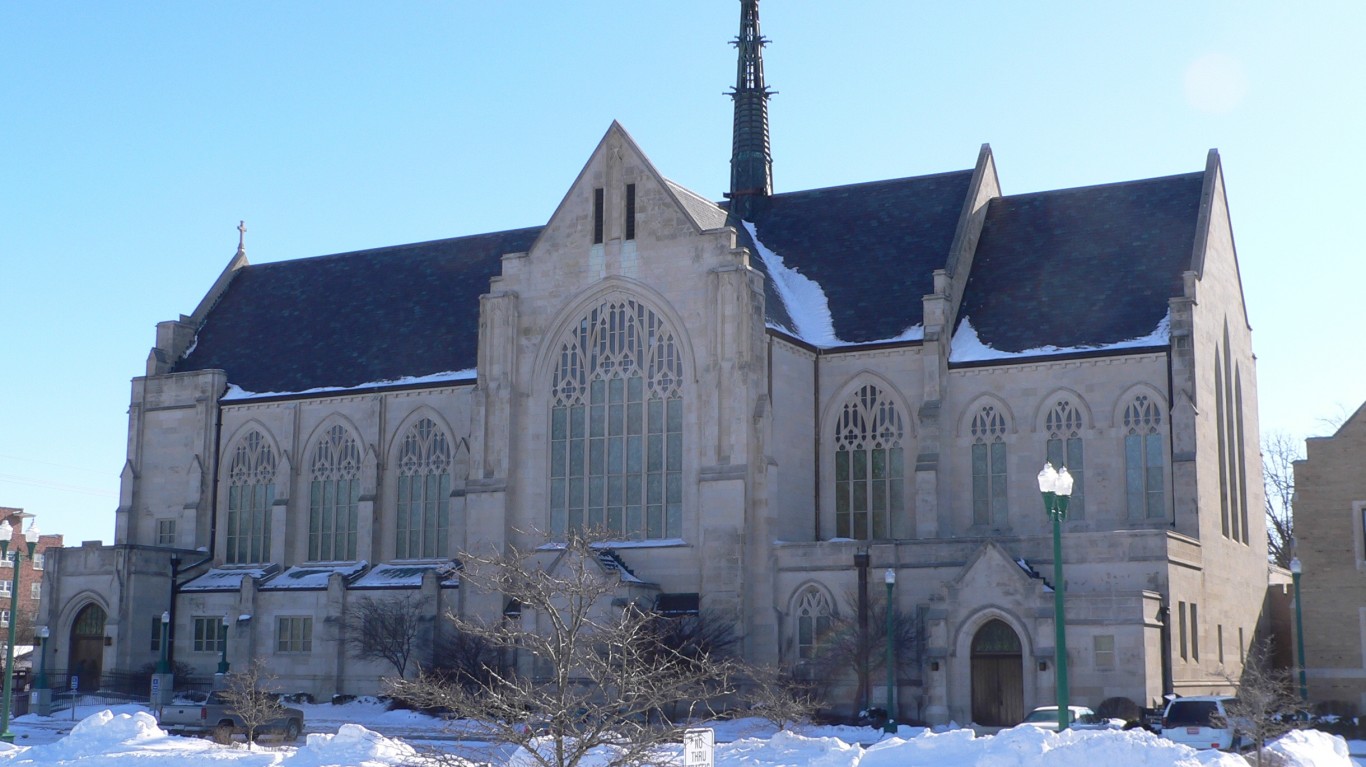
Nebraska: Grand Island
Avg. new daily cases in Grand Island in week ending June 14: 30.9 per 100,000
Avg. new daily cases in Grand Island in week ending June 7: 34.3 per 100,000
COVID-19 cases in Grand Island as of June 14: 19,589 (25,952.6 per 100,000)
Peak pandemic unemployment in Grand Island: 11.4% (April 2020)
Grand Island population: 75,480 (47.2 people per sq. mi.)

Nevada: Las Vegas-Henderson-Paradise
Avg. new daily cases in Las Vegas in week ending June 14: 35.0 per 100,000
Avg. new daily cases in Las Vegas in week ending June 7: 36.3 per 100,000
COVID-19 cases in Las Vegas as of June 14: 563,205 (25,811.4 per 100,000)
Peak pandemic unemployment in Las Vegas: 34.2% (April 2020)
Las Vegas population: 2,182,004 (276.5 people per sq. mi.)
These are all the counties in Nevada where COVID-19 is slowing (and where it’s still getting worse).

New Hampshire: Manchester-Nashua
Avg. new daily cases in Manchester in week ending June 14: 23.6 per 100,000
Avg. new daily cases in Manchester in week ending June 7: 28.3 per 100,000
COVID-19 cases in Manchester as of June 14: 105,476 (25,536.8 per 100,000)
Peak pandemic unemployment in Manchester: 17.5% (April 2020)
Manchester population: 413,035 (471.4 people per sq. mi.)

New Jersey: Trenton-Princeton
Avg. new daily cases in Trenton in week ending June 14: 43.5 per 100,000
Avg. new daily cases in Trenton in week ending June 7: 53.9 per 100,000
COVID-19 cases in Trenton as of June 14: 86,338 (23,466.4 per 100,000)
Peak pandemic unemployment in Trenton: 12.4% (June 2020)
Trenton population: 367,922 (1,638.4 people per sq. mi.)

New Mexico: Santa Fe
Avg. new daily cases in Santa Fe in week ending June 14: 64.2 per 100,000
Avg. new daily cases in Santa Fe in week ending June 7: 50.1 per 100,000
COVID-19 cases in Santa Fe as of June 14: 31,436 (21,056.6 per 100,000)
Peak pandemic unemployment in Santa Fe: 13.2% (July 2020)
Santa Fe population: 149,293 (78.2 people per sq. mi.)

New York: Poughkeepsie-Newburgh-Middletown
Avg. new daily cases in Poughkeepsie in week ending June 14: 60.5 per 100,000
Avg. new daily cases in Poughkeepsie in week ending June 7: 94.6 per 100,000
COVID-19 cases in Poughkeepsie as of June 14: 190,365 (28,250.8 per 100,000)
Peak pandemic unemployment in Poughkeepsie: N/A (N/A)
Poughkeepsie population: 673,839 (419.2 people per sq. mi.)

North Carolina: Raleigh-Cary
Avg. new daily cases in Raleigh in week ending June 14: 62.3 per 100,000
Avg. new daily cases in Raleigh in week ending June 7: 68.3 per 100,000
COVID-19 cases in Raleigh as of June 14: 406,310 (30,496.6 per 100,000)
Peak pandemic unemployment in Raleigh: 11.7% (May 2020)
Raleigh population: 1,332,311 (629.0 people per sq. mi.)
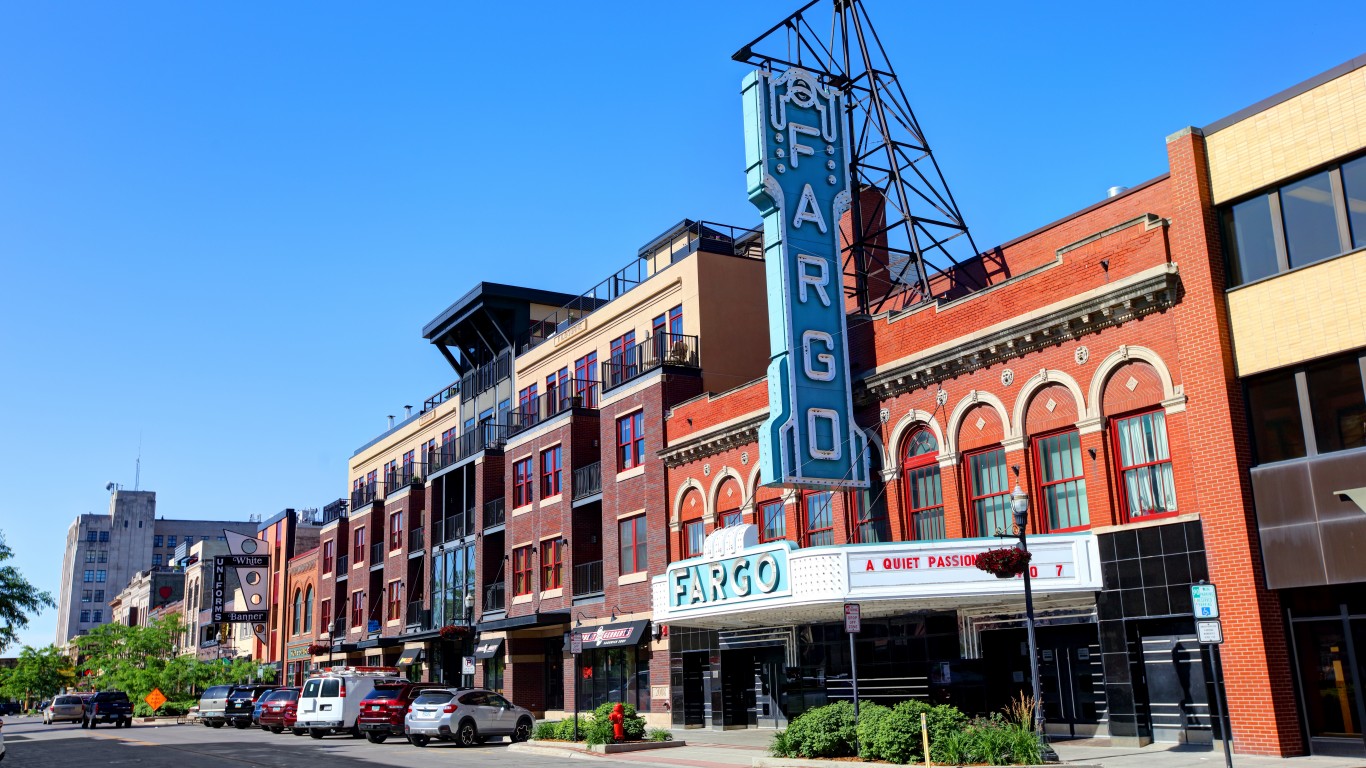
North Dakota: Fargo, ND-MN
Avg. new daily cases in Fargo in week ending June 14: 27.9 per 100,000
Avg. new daily cases in Fargo in week ending June 7: 30.3 per 100,000
COVID-19 cases in Fargo as of June 14: 81,869 (34,052.4 per 100,000)
Peak pandemic unemployment in Fargo: 7.7% (April 2020)
Fargo population: 240,421 (85.5 people per sq. mi.)

Ohio: Cincinnati, OH-KY-IN
Avg. new daily cases in Cincinnati in week ending June 14: 28.3 per 100,000
Avg. new daily cases in Cincinnati in week ending June 7: 24.9 per 100,000
COVID-19 cases in Cincinnati as of June 14: 561,946 (25,522.8 per 100,000)
Peak pandemic unemployment in Cincinnati: 14.5% (April 2020)
Cincinnati population: 2,201,741 (483.6 people per sq. mi.)
These are all the counties in Ohio where COVID-19 is slowing (and where it’s still getting worse).

Oklahoma: Oklahoma City
Avg. new daily cases in Oklahoma City in week ending June 14: 15.0 per 100,000
Avg. new daily cases in Oklahoma City in week ending June 7: 13.8 per 100,000
COVID-19 cases in Oklahoma City as of June 14: 369,107 (26,691.9 per 100,000)
Peak pandemic unemployment in Oklahoma City: 15.2% (April 2020)
Oklahoma City population: 1,382,841 (250.9 people per sq. mi.)

Oregon: Bend
Avg. new daily cases in Bend in week ending June 14: 50.0 per 100,000
Avg. new daily cases in Bend in week ending June 7: 45.2 per 100,000
COVID-19 cases in Bend as of June 14: 50,564 (27,148.3 per 100,000)
Peak pandemic unemployment in Bend: 18.3% (April 2020)
Bend population: 186,251 (61.7 people per sq. mi.)
These are all the counties in Oregon where COVID-19 is slowing (and where it’s still getting worse).

Pennsylvania: East Stroudsburg
Avg. new daily cases in East Stroudsburg in week ending June 14: 32.3 per 100,000
Avg. new daily cases in East Stroudsburg in week ending June 7: 36.6 per 100,000
COVID-19 cases in East Stroudsburg as of June 14: 39,528 (23,524.1 per 100,000)
Peak pandemic unemployment in East Stroudsburg: 20.5% (April 2020)
East Stroudsburg population: 168,032 (276.2 people per sq. mi.)

Rhode Island: Providence-Warwick, RI-MA
Avg. new daily cases in Providence in week ending June 14: 34.6 per 100,000
Avg. new daily cases in Providence in week ending June 7: 43.8 per 100,000
COVID-19 cases in Providence as of June 14: 524,998 (32,442.0 per 100,000)
Peak pandemic unemployment in Providence: 18.5% (April 2020)
Providence population: 1,618,268 (1,019.8 people per sq. mi.)

South Carolina: Charleston-North Charleston
Avg. new daily cases in Charleston in week ending June 14: 42.3 per 100,000
Avg. new daily cases in Charleston in week ending June 7: 27.4 per 100,000
COVID-19 cases in Charleston as of June 14: 228,335 (29,481.3 per 100,000)
Peak pandemic unemployment in Charleston: 12.3% (April 2020)
Charleston population: 774,508 (299.2 people per sq. mi.)
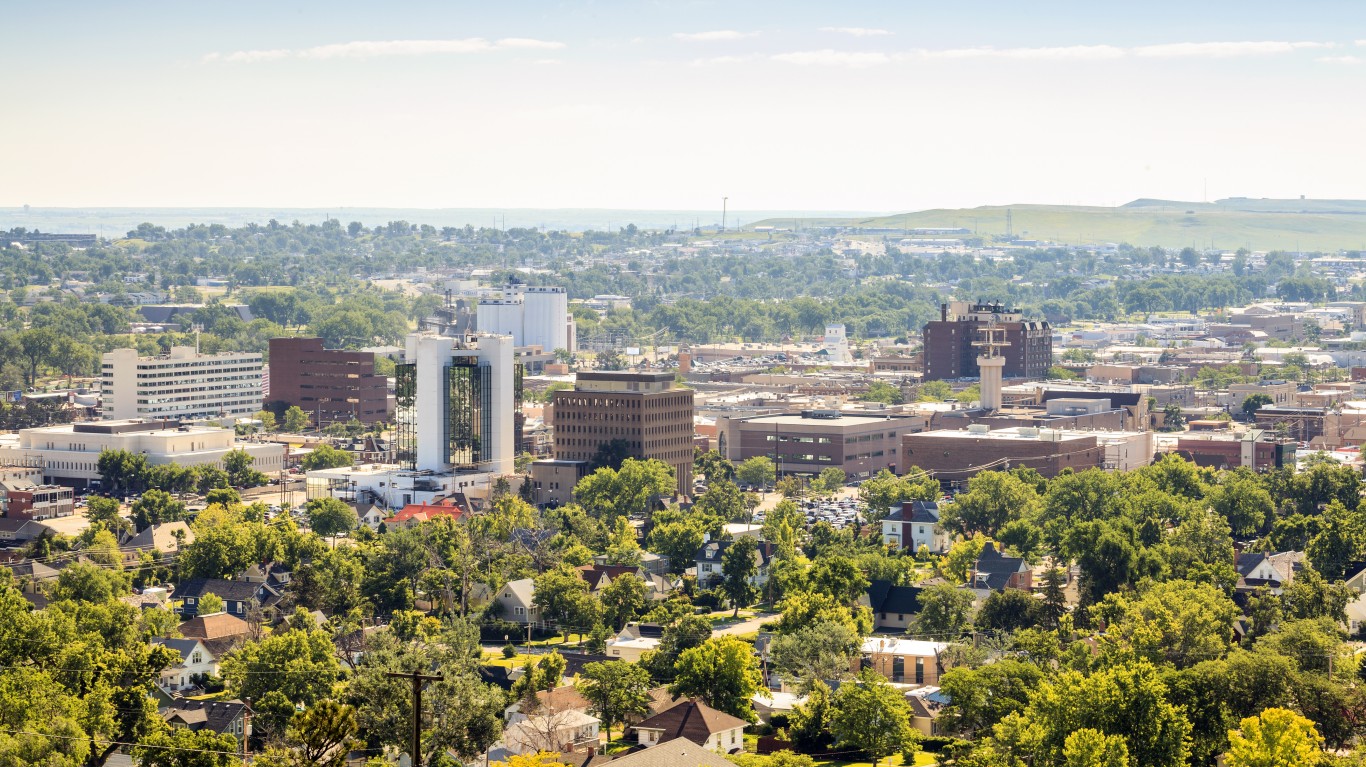
South Dakota: Rapid City
Avg. new daily cases in Rapid City in week ending June 14: 25.1 per 100,000
Avg. new daily cases in Rapid City in week ending June 7: 17.9 per 100,000
COVID-19 cases in Rapid City as of June 14: 40,622 (29,350.7 per 100,000)
Peak pandemic unemployment in Rapid City: 13.8% (April 2020)
Rapid City population: 138,402 (22.2 people per sq. mi.)

Tennessee: Memphis, TN-MS-AR
Avg. new daily cases in Memphis in week ending June 14: 39.3 per 100,000
Avg. new daily cases in Memphis in week ending June 7: 27.0 per 100,000
COVID-19 cases in Memphis as of June 14: 362,386 (27,051.3 per 100,000)
Peak pandemic unemployment in Memphis: 13.4% (April 2020)
Memphis population: 1,339,623 (292.6 people per sq. mi.)

Texas: Houston-The Woodlands-Sugar Land
Avg. new daily cases in Houston in week ending June 14: 35.0 per 100,000
Avg. new daily cases in Houston in week ending June 7: 28.6 per 100,000
COVID-19 cases in Houston as of June 14: 1,651,878 (23,995.4 per 100,000)
Peak pandemic unemployment in Houston: 14.7% (April 2020)
Houston population: 6,884,138 (833.6 people per sq. mi.)
These are all the counties in Texas where COVID-19 is slowing (and where it’s still getting worse).

Utah: Salt Lake City
Avg. new daily cases in Salt Lake City in week ending June 14: 37.2 per 100,000
Avg. new daily cases in Salt Lake City in week ending June 7: 39.1 per 100,000
COVID-19 cases in Salt Lake City as of June 14: 380,358 (31,669.0 per 100,000)
Peak pandemic unemployment in Salt Lake City: 11.3% (April 2020)
Salt Lake City population: 1,201,043 (156.3 people per sq. mi.)
These are all the counties in Utah where COVID-19 is slowing (and where it’s still getting worse).

Vermont: Burlington-South Burlington
Avg. new daily cases in Burlington in week ending June 14: 16.3 per 100,000
Avg. new daily cases in Burlington in week ending June 7: 37.3 per 100,000
COVID-19 cases in Burlington as of June 14: 47,224 (21,584.8 per 100,000)
Peak pandemic unemployment in Burlington: 14.8% (April 2020)
Burlington population: 218,784 (174.7 people per sq. mi.)

Virginia: Charlottesville
Avg. new daily cases in Charlottesville in week ending June 14: 39.8 per 100,000
Avg. new daily cases in Charlottesville in week ending June 7: 43.5 per 100,000
COVID-19 cases in Charlottesville as of June 14: 42,690 (19,814.8 per 100,000)
Peak pandemic unemployment in Charlottesville: 10.2% (April 2020)
Charlottesville population: 215,445 (131.0 people per sq. mi.)
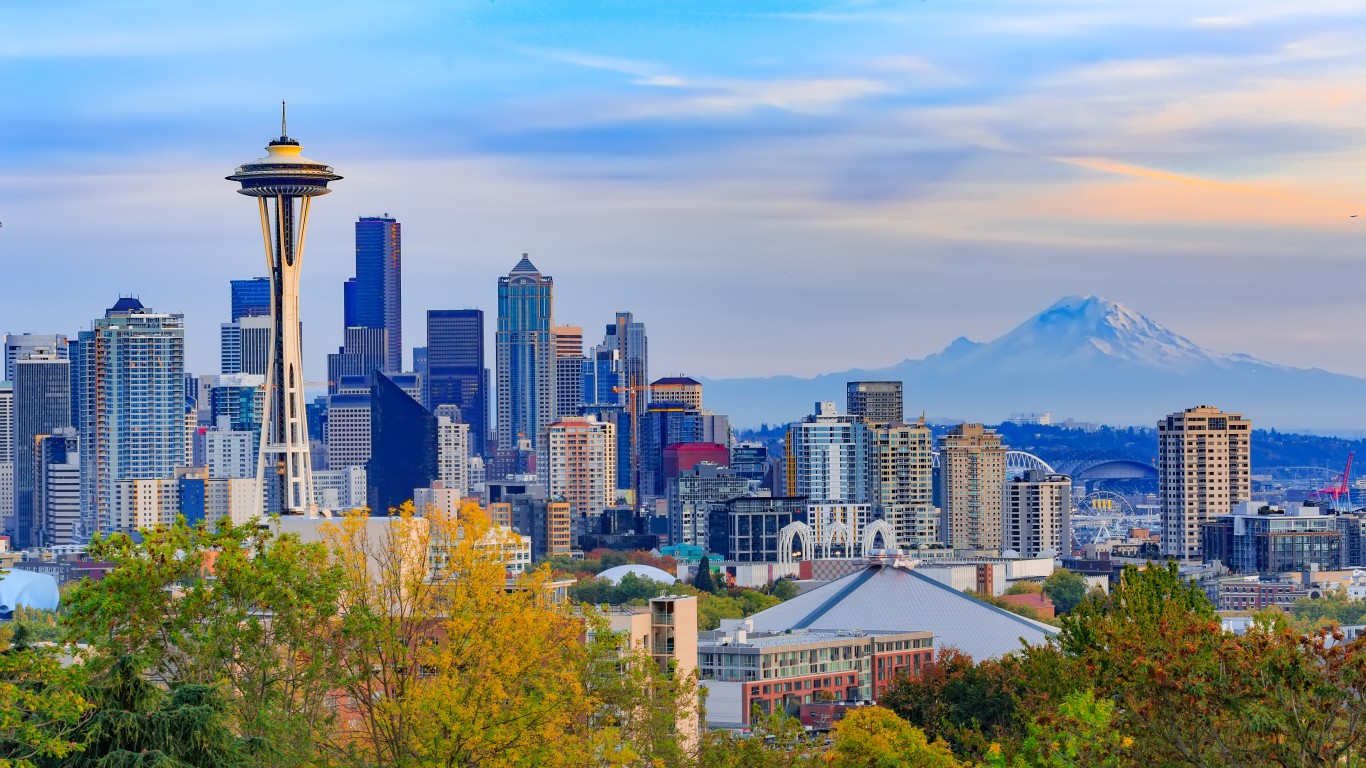
Washington: Seattle-Tacoma-Bellevue
Avg. new daily cases in Seattle in week ending June 14: 51.0 per 100,000
Avg. new daily cases in Seattle in week ending June 7: 46.2 per 100,000
COVID-19 cases in Seattle as of June 14: 820,512 (21,194.6 per 100,000)
Peak pandemic unemployment in Seattle: 17.3% (April 2020)
Seattle population: 3,871,323 (659.2 people per sq. mi.)

West Virginia: Beckley
Avg. new daily cases in Beckley in week ending June 14: 39.9 per 100,000
Avg. new daily cases in Beckley in week ending June 7: 35.5 per 100,000
COVID-19 cases in Beckley as of June 14: 37,621 (31,660.0 per 100,000)
Peak pandemic unemployment in Beckley: 18.4% (April 2020)
Beckley population: 118,828 (93.8 people per sq. mi.)

Wisconsin: Madison
Avg. new daily cases in Madison in week ending June 14: 59.8 per 100,000
Avg. new daily cases in Madison in week ending June 7: 64.7 per 100,000
COVID-19 cases in Madison as of June 14: 176,146 (26,945.0 per 100,000)
Peak pandemic unemployment in Madison: 11.6% (April 2020)
Madison population: 653,725 (197.5 people per sq. mi.)
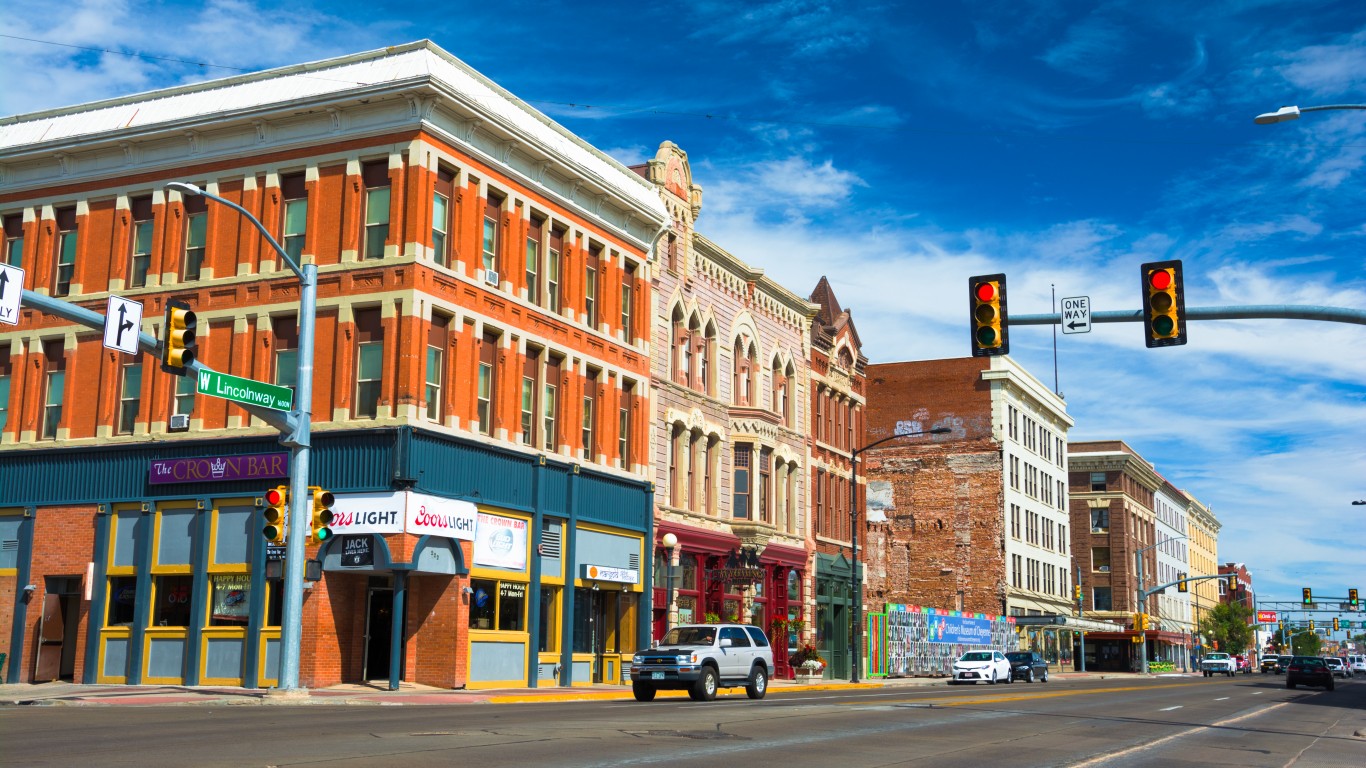
Wyoming: Cheyenne
Avg. new daily cases in Cheyenne in week ending June 14: 33.5 per 100,000
Avg. new daily cases in Cheyenne in week ending June 7: 20.4 per 100,000
COVID-19 cases in Cheyenne as of June 14: 26,886 (27,345.4 per 100,000)
Peak pandemic unemployment in Cheyenne: 9.2% (April 2020)
Cheyenne population: 98,320 (36.6 people per sq. mi.)
Click here to see all coronavirus data for every state.
Thank you for reading! Have some feedback for us?
Contact the 24/7 Wall St. editorial team.